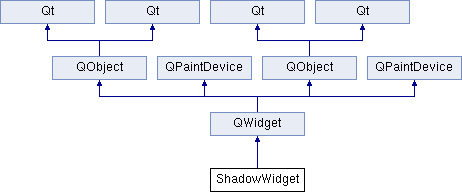|
Eneboo - Documentación para desarrolladores
|
|
Eneboo - Documentación para desarrolladores
|
#include <msgedit.h>

Métodos públicos | |
| ShadowWidget (QWidget *parent=0, const char *name=0) | |
| ShadowWidget (QWidget *child, QWidget *parent=0, const char *name=0) | |
| void | setShadowWidth (int width) |
| int | shadowWidth () const |
| void | setMargin (int margin) |
| int | margin () const |
| void | setWidget (QWidget *child) |
Métodos protegidos | |
| void | resizeEvent (QResizeEvent *e) |
| void | paintEvent (QPaintEvent *e) |
| ShadowWidget::ShadowWidget | ( | QWidget * | parent = 0, |
| const char * | name = 0 |
||
| ) |
| int ShadowWidget::margin | ( | ) | const [inline] |
| void ShadowWidget::paintEvent | ( | QPaintEvent * | ) | [protected, virtual] |
This event handler can be reimplemented in a subclass to receive paint events.
A paint event is a request to repaint all or part of the widget. It can happen as a result of repaint() or update(), or because the widget was obscured and has now been uncovered, or for many other reasons.
Many widgets can simply repaint their entire surface when asked to, but some slow widgets need to optimize by painting only the requested region: QPaintEvent::region(). This speed optimization does not change the result, as painting is clipped to that region during event processing. QListView and QCanvas do this, for example.
Qt also tries to speed up painting by merging multiple paint events into one. When update() is called several times or the window system sends several paint events, Qt merges these events into one event with a larger region (see QRegion::unite()). repaint() does not permit this optimization, so we suggest using update() when possible.
When the paint event occurs, the update region has normally been erased, so that you're painting on the widget's background. There are a couple of exceptions and QPaintEvent::erased() tells you whether the widget has been erased or not.
The background can be set using setBackgroundMode(), setPaletteBackgroundColor() or setBackgroundPixmap(). The documentation for setBackgroundMode() elaborates on the background; we recommend reading it.
Reimplementado de QWidget.
| void ShadowWidget::resizeEvent | ( | QResizeEvent * | ) | [protected, virtual] |
This event handler can be reimplemented in a subclass to receive widget resize events. When resizeEvent() is called, the widget already has its new geometry. The old size is accessible through QResizeEvent::oldSize().
The widget will be erased and receive a paint event immediately after processing the resize event. No drawing need be (or should be) done inside this handler.
Widgets that have been created with the WNoAutoErase flag will not be erased. Nevertheless, they will receive a paint event for their entire area afterwards. Again, no drawing needs to be done inside this handler.
The default implementation calls updateMask() if the widget has automatic masking enabled.
Reimplementado de QWidget.
| void ShadowWidget::setMargin | ( | int | margin | ) | [inline] |
| void ShadowWidget::setShadowWidth | ( | int | width | ) | [inline] |
| void ShadowWidget::setWidget | ( | QWidget * | child | ) |
| int ShadowWidget::shadowWidth | ( | ) | const [inline] |
 1.7.4
1.7.4